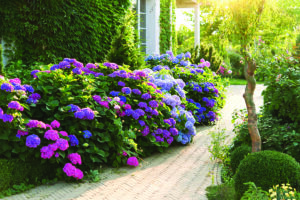
The soil pH influences the color of macrophylla hydrangea flowers.
Soil pH — a measure of soil acidity and alkalinity — is crucial in the landscape because it affects nutrient availability and overall plant health.
Fall is the perfect time to check for and adjust soil pH.
All plants have a specific pH preference, with most preferring a neutral range of 6.0 to 7.0. Soil pH scale ranges from 0 (extremely acidic) to 14 (extremely alkaline), with 7 being neutral.
Understanding your landscape’s soil pH needs, will help in the selection of appropriate plants and amendments needed to adjust pH levels, allowing for ultimate plant health.
Plants need nutrients to be dissolved in the soils water, so the plant can absorb them.
Extreme pH levels can cause nutrients to become insoluble, making them unavailable for the plant to absorb.
If pH is too high or too low for a plant, it can lead to nutrient deficiencies, poor plant growth and increased susceptibility to pests and diseases.
Soil pH levels also influence beneficial soil microorganisms, such as those that decompose organic matter, which overall improves the soil.
So remember, it doesn’t matter how much organic matter is available or how much fertilizer you add, even organic fertilizers, the plants simply cannot absorb any of it if the pH is not in check and balanced.
Testing and adjusting soil pH is simple and easy.
First, test your soil, you can buy inexpensive pH meters from any garden center or hardware store.
You can also take samples to a local University of Maryland Extension office, to have tested for a small fee.
Determine the readings and adjust pH as necessary, to raise pH apply lime.
The amount depends on your soil’s texture and organic matter content, so follow label instructions.
To lower pH add sulfur, which is the best and most effective choice, again follow label instructions.
For severe cases, you may have to check the pH in three months and apply a follow-up application to reach the desired range.
Remember most garden plants prefer a soil pH range of 6.0 to 7.0, lawns like it 5.5 to 6.0,
Azaleas and Rhododendron and blueberries like it 4.5 to 5.5.
Macrophylla Hydrangeas are starting to produce flower buds for next spring.
Be sure to water weekly in the absence of rain and use no fertilizers.
Soon after Halloween, when flower buds have formed, the plant goes dormant for the winter.
Remember to check the soil pH to ensure good color when the flower bloom begins.
The list below shows how soil pH influences the color of macrophylla hydrangea flowers:
• If soil pH is below 4.5, flowers will be a variety of purple shades;
• If soil pH is between 4.5 and 5.5, flowers will be blue;
• If soil pH is between 5.5 and 6.5, flowers will be pink;
• If soil pH is between 6.5 and 7.0, flowers will be white; and
• If soil pH is between 7.0 and 8.0, flowers will be red.
Lower pH by using a soil acidifier, and to raise pH by using garden lime.
Hosta plants are beginning to go dormant.
After the foliage has yellowed and browned, cut the stalks back to the ground.
Check the pH now and adjust, it needs to be between 6.0 and 7.0, to be on target for the new growth in the spring.
Asparagus plants like a pH of around 7.0 and peony plants like a range of 6.5 to 7.0.
Remember, fall is the right time to make the necessary pH adjustments.
Vegetables need certain nutrients for them to perform well and to achieve a good crop.
The best time to make the adjustments to the soil is in the fall, after the last harvest.
Work up the ground and add organic manure or leafgro.
This will improve not only the nutrient content, but also the texture of the soil.
In the heavy clay soils, like we have in Talbot County, this addition is essential.
Check the pH of the soil as well, remembering most vegetables require a pH in the range of 6.5 to 7.5, in order for the plant to uptake any nutrients available.
Adjusting the soil in the fall will allow plenty of time for the pH to adjust in the desired range.
Remember to use lime to raise pH and a soil acidifier to lower pH.
Other considerations should also include adding an amendment like Espoma’s Garden Gypsum to help loosen the heavy clay soils and help reduce compaction.
Planting a cover crop in the fall and tilling it under in the spring will go a long way as well in improving the soil.
Oats, barley, wheat and vetch make great cover crops and be purchased in smaller quantities, perfect for your garden.
Enjoy the fall weather and happy gardening!
(Editor’s note: Ken Morgan is the owner of Robin’s Nest Floral and Garden Center in Easton, Md.)



